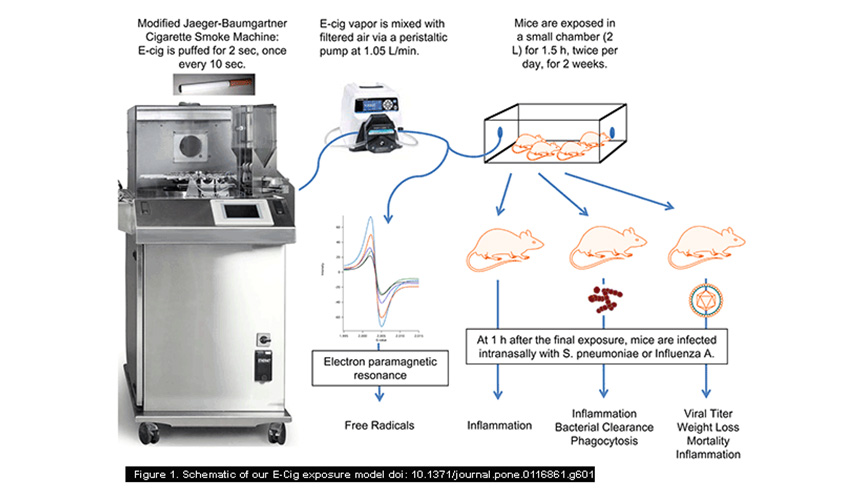Toxic Radials
Study finds free radical toxins, harmful aerosols in e-cigarettes
Electronic- or e-cigarettes release damaging free radical toxins during the vaporization process, and exposure to e-cigarette aerosols can cause airway inflammation and compromise the immune system, according to new research published in the open-access journal PLOS ONE.
A team of researchers at the Children’s Foundation Research Institute at Le Bonheur Children’s Hospital joined scientists at Johns Hopkins School of Public Health to study the health effects of e-cigarette vapors in mice.
In the study, mice were divided into two groups: one group was exposed to clean air and the other group was exposed to e-cigarette aerosol for two weeks at levels similar to those of a human smoking or “vaping” an e-cigarette.
Researchers found the e-cigarette creates combustion particles that contain 7 x 10e11 free radicals per puff and that a two-week exposure produced a significant increase in oxidative stress and moderate macrophage-mediated inflammation in mice. These mice showed significantly impaired immune responses to both bacteria and viruses. In fact, mice exposed to e-cigarette vapors were less able to clear the bacteria, Streptococcus pneumonia, from their lungs.
In response to Influenza A infection, e-cigarette-exposed mice displayed increased amounts of virus in their lungs and enhanced virus-induced illness including weight loss and mortality.

Le Bonheur researcher Stephania Cormier, PhD, and her team measured the free radical content of e-cigarette exposure using electron paramagnetic resonance spectroscopy. Free radicals are especially reactive molecules that can damage cells, proteins and DNA, causing disease. The free radicals produced by “vaping” are typically associated with combustion processes. They are especially dangerous because they are stabilized on the surface of the particles formed during the vaporization process, persisting in the environment for days to months, and in biological solutions for hours.
“We know that e-cigarette users inhale more puffs compared to regular cigarette users in order to get the same amount of nicotine,” Cormier said. “Because of that, users are exposed to higher levels of these damaging free radicals.”
Cormier leads one of only a few labs in the world to study free radicals – which are often found in homes with gas, wood or kerosene-burning stoves. She leads a National Institute of Environmental Health Sciences Superfund Research Program to study the how environmentally persistent free radicals are formed and affect human respiratory and cardiac health.
Cormier said she became interested in studying the effects of e-cigarettes on airway function and pulmonary immune responses after a friend starting using e-cigarettes as he tried to stop smoking. Her expertise on pollutants that are released into the air during the combustion process made her well suited for the work.
E-cigarettes are also of interest to her, she says, because they are largely marketed to young adults and teens – with candy and fruit-flavors. The American Academy of Pediatrics (AAP) has called for the Food and Drug Administration to oversee the unregulated e-cigarettes. The AAP and the American Association of Poison Control Centers have called on Congress to pass the Child Nicotine Poisoning Prevention Act, which would require child safety packaging for liquid nicotine containers and for other purposes.
In November 2014, the Centers for Disease Control and Prevention (CDC) reported that fewer U.S. high school students are smoking traditional cigarettes, but current use (use on one or more days in the past 30 days) of e-cigarettes by high school students tripled to 4.5 percent in 2013 from 1.5 percent in 2011. The CDC also reported that 22.9 percent of high school students said they were currently using tobacco.
“I hope that this study shows consumers that e-cigarettes are not a healthful alternative to regular cigarettes. They are not a way to quit. I think they are going to cause a lot of health problems for teens and young adult users,” said Cormier.
Help us provide the best care for kids.
Le Bonheur Children's Hospital depends on the generosity of friends like you to help us serve 250,000 children each year, regardless of their family’s ability to pay. Every gift helps us improve the lives of children.
Donate Now









